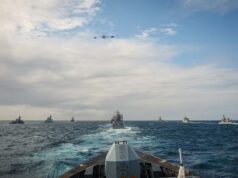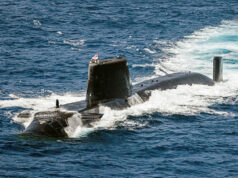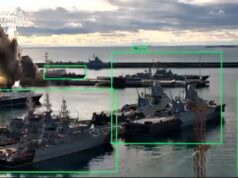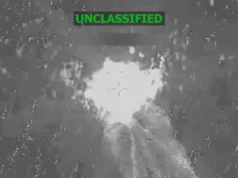Two years into the FC/ASW (Future Cruise/Anti-Ship Weapon) Concept Phase, MBDA has announced the successful achievement of its “Key Review”, jointly conducted with Defence Equipment and Support (DE&S) and the Direction Générale de l’Armement (DGA), the British and French armament procurement agencies.
The conclusion of this Key Review makes it possible to select the most promising missile concepts in order to meet the requirements expressed by both nations’ armed forces.
The firm says that more in-depth studies will now be conducted on these concepts with the aim of identifying the solutions that will be selected at the end of the concept phase in 2020 in order to answer both nations’ requirements for long range anti-ship missions, suppression of enemy air defences and deep strike.
“The conclusions of this study will also make it possible to establish the road maps for maturing the technologies required, and to launch any follow on assessment phase.
This new phase will demonstrate the necessary maturity of the weapon system and its key components, to be followed by the development and production phase in the 2024 timeframe, so that current weapons systems can be replaced in accordance with required timescales.”
The FC/ASW programme was born from converging requirements expressed by both France and the UK for a long range anti-ship capability – to deal with the possibility of a confrontation on the high seas, a capability to neutralise the most advanced air defences, and a deep strike capability that can penetrate defences and hit long-distance hardened targets.
The FC/ASW aims to replace Storm Shadow/SCALP air launched cruise missile in operational service in the UK and France as well as Exocet anti-ship missile in France and Harpoon anti-ship missile in the UK.
Equally funded by France and the UK, the FC/ASW Concept Phase is a product of the defence relationship set out between both nations by the Lancaster House treaties.
Valued at €100 million, the current Concept Phase was launched in 2017 for a duration of three years and is split 50/50 in terms of both quantity and quality of content between the UK and France. The effort will see MBDA mature systems and technologies that will increase the survivability, range and lethality of anti-ship and deep strike missiles launched by both air and naval combat platforms.













Great ? we really need them…
Is this missile really intended as a replacement for Harpoon and Exocet though? If its replacing Storm Shadow/SCALP then its replacing a missile with >2x the overall mass, >2x the warhead mass and >3x the range of Harpoon and Exocet. Regardless of whether it ends up as high sub-sonic stealth or a Mach 3 class supersonic missile, it seems to be in a very different class, with probably a significantly different price point.
For the UK at least it seems to make more sense to select JSM as the Harpoon class replacement; it will be a much more useful missile than what it replaces, given the number of different launch platforms including F35B (wing mount only) and the multi-role use. It may also be available by the Harpoon out of service date or shortly afterwards, avoiding a wasteful interim solution. For France it seems to make sense to do an Exocet update for their own use and future sales to other existing Exocet customers.
Then FC/ASW is the high end, multi-role capability, that complements the JSM with a far more capable solution. Storm Shadow has similar mass and warhead size to Tomahawk but lower range, so FC/ASW seems to be the solution to address Tomahawk replacement too.
Also, our T31’s and T45’s will need to have a means of sinking ships. With both unlikely to get mk41 cells, and the fact it is unlikely this missile will be available on a deck mounted launcher, it would leave nothing for them. Therefore we will need something along the lines of NSM, and not just as an interim purchase. We really will need two classes of asm.
I remain skeptical on warship-to-warship ASM use for the UK because submarine and air-launched attacks seem far better tactics, unless we expect singleton engagements between pairs of ships in the middle of the ocean somewhere, in which case other measures to avoid this would seem to have failed. That’s why I am not that concerned over the demise of Harpoon. I think I get why Russia likes ship based ASM but I can’t see why NATO would want to get into ship-to-ship exchanges with them and play to Russia’s strength (ditto China), except from small fast coastal vessels like Norway’s, or those from non-members Sweden and Finland.
However, what really appeals to me is the multi-role, multi platform launch capabilities of these modern missiles because it provides far greater flexibility, utilisation, efficiency, simplified logistics and helps lower costs versus the dedicated functionality of past missiles such as Harpoon.
All that said, as long as the missiles are in inventory and available in canister mount then there is always the option to use on T45 and T31. I too believe additional Sylver/Mk41 VLS for T45 seems unlikely mostly because we would have to qualify a lot of new-to-UK different missiles to get any utility out of them, but adding Sea Ceptor cold launch cells instead could free up Sylver cells for more Aster 30 including Block 1NT and uses other than Asters in future. I also hope that T31 is fitted with at least some Mk41 strike length cells, even if rarely populated, again because of flexibility to scale capabilities in heightened tensions, particularly as these ships will most likely patrol alone.
In the last para the utility comment was wrt MK41 in the short term/next ten years. Additional Sylver cells would increase current missile loadout capability immediately.
If we had 12 SSN’s (and perhaps some SSK’s) then yes. And if expect the only kinetic events to happen with the carrier present.
Across the Pond there has been a lot of talk about the surface fleet’s lack of lethality and the UK is worse off. Does Aster 30 have an anti-surface capability? I know SM3 does.
Yes OTH targeting is problematic. But we mustn’t over look the deterrent factor either.
The GIUK gap would be a formidable line to breach for the Russian surface fleet. UK, Norwegian, US and perhaps even Canadian P-8’s based in Norway, Scotland, Iceland, Greenland and Newfoundland would be patrolling to track ships and detect submarines, with land based jets primarily prosecuting attacks with ASM on the ships IMV. So no requirement for carrier aircraft, although escorting surface ships from US reinforcing Europe would justify carrier use in addition IMV.
I suspect submarines would be primarily tasked to hunt other submarines, but even then the UK wouldn’t be patrolling alone, their would be Norwegian and US subs, probably along with subs from other European nations because frankly what else would they be doing in the event of all out conflict? Some in the Baltic and Med for sure but not all of them.
Sorry, the Aster comment is probably confusing, looking at it in hindsight. I made that in response to T.S in the context of freeing up VLS and what the extra cells might be used for on T45. I don’t know of any plan to use Aster for anything other than AAW.
And yes I agree that OTH targeting is a thing 😉 We can’t just blindly fire long range missiles and hope they find a moving ship (and the right ship at that) to hit. That’s why I see escort ship based AEW as an increasingly important asset for more than just carriers in future. For the UK that might be Merlin based Crowsnest or perhaps V247 or similar in the longer term. Leveraging satellite data as well assuming they are still there.
One option may be to do a similar thing to what the Americans did with the JASSM-ER which LRASM is based off. Some of the electronics are different but the airframe is common, lowering development costs. LRASM does have about 200 miles less range though so I agree with you in that we can’t assume Perseus will be able to do everything.
My perspective is that Perseus might well be able to do it all but the question would be at what cost. If a £1M missile will do the job, why fire off a £2-3M missile (I’ll be pleasantly surprised if Perseus is less than this), especially if multiple lower cost missiles may have a better chance of penetrating target defenses. But its also a case of loading and aircraft flying range trade-offs for an F35B between the two missiles.
Now if Perseus became a program of two missiles with shared components, then that might work but we’d be back to a capability gap after Harpoon, something I could accept for reasons given in my other post, especially if SPEAR 3 is used for a light ASM role, but I am in the minority on this.
Multi role is the way forward, modern processors ,multi mode sensors and multi mode warheads allow for a lot of different target sets and reduces the number of types we need to manage.It also allows the platforms they are carried by to be very flexible in the application of force.We should never consider expensive single role weapons again, look at Brimstone,Spear 3 as good examples and of coarse the American SM6 is a great example,anti air,anti ballistic missile,anti ship and even fixed position land attack all in one package.
Being intelligent about the application of force using multi-role, multi-platform solutions is key IMO to efficiency and affordability in the armed services, as well as collateral damage management.
SM6 is a great example of multi-role, but also a very expensive one too, which is why we need a range of escalating ASM capability – Martlet, Sea Venom, SPEAR3, JSM and FC/ASW (Perseus) – which all include land attack capability but not the SAM capability of SM-6.
How much of this missile will be built in Britain?
We get to produce the stickers. Not a bad deal for 90% of the development costs…….. 🙂
As article states development costs 50-50 and likely result will be a missile produced to same design and same parts by two different final assemblers, possibly having localised performance tweaking to meet each countries specific role requirements.
Well if we get stickers I’m definately in!
Why is it red? Will the real thing be red?
No. FWIW red is the colour of drill rounds……….
https://upload.wikimedia.org/wikipedia/commons/thumb/8/84/Drill_Sea_Dart_Missiles_Onboard_HMS_Edinburgh_MOD_45153846.jpg/1200px-Drill_Sea_Dart_Missiles_Onboard_HMS_Edinburgh_MOD_45153846.jpg
Only Sea dart was red because they look steely on the launcher during Alpha.
All other drill weapons where /are blue
Skua and wolf where. 4.5 drill round is blue… Sting Ray is black but it has a blue band. Now with most missiles being VLS the blue/red missiles days are numbered.
I’m sorry but for 2 countries who have been knocking out various types of missile for decades the timeline for this is ridiculous, meanwhile Russia seems to produce vastly superior missiles at a fraction of the cost and much faster.
I know there isn’t a huge imperative to get this into service but the way things are going I wouldn’t want to wait that long
Russia produces vastly superior missiles? I seriously doute that. They can’t make one aircraft carrier work without a fleet of tugs.
Indeed who is telling us this?
1) Putin and his lackies with the aim of promoting the perception of technical and military excellence when more often than not the realities are embarrassing to them.
2) Western (mostly American) military analysts usually with links to Government, Politics, military or arms suppliers who up the threat so as to get ‘equivalent’ or defensive options the go ahead they may not otherwise obtain.
I remember back in the day awesome Russian air superiority fighters being used to achieve this due to their superior manoverabilty and apparent massive speed advantage over western aircraft. 25 years later the latter are still the mainstay of US air power and the Russian fighters were found to reach these speeds for about 2 minutes before running out of fuel and the debate on the advantages of thrust vectoring is still unresolved. Meanwhile the F22 built off the back of that fear is, despite its advanced capabilities is deemed by many unsustainable in terms of cost and reliability and even talked of as being gradually phased out for F35s I heard last week. So let’s see just how these supposed threats turn out for real before over selling their capabilities. Meanwhile sensible developments in our own capabilities should be sustained of course just not in a panic environment.
Deciding if it’s to be red, or a completely different colour, is the next stage of assessment nominally costed at euro 70 million, I believe.
Don’t be silly, both countries use the same colours don’t ya know, it’s just a debate around whether it should be red white and blue or blue, white and red.
The French are open to compromise on this issue, as always. Bleu would be acceptable if it’s sacre.
Or more likely the French are planning to leave the programme just as soon as it is viable, finalised and has ironed out all development costs. Then they will manufacture their own missile using stolen Perseus intellectual property and call it the Macron or exocet 2 or some such.
Mark my words this missile will consume hundreds of millions or billions and not enter production. Or it will but at exuberant cost. Better to just purchase thousands of NSMs and saturate a targets ability to defend against them.
On other programs you may have a point, but Meteor, Storm Shadow/Scalp and Sea Venom are examples of missile programs where cooperation has worked.
Not far off being nuclear armed for the UK and France…
I am not sure why a dedicated anti-ship missile is a bad idea. The F35 can be given a land atrack missile. The T26 will have 24 strike length for a wide range of missiles. The RN needs a modern super/hypersonic anti-ship missile, I doubt stealth alone will be enoght to get through a future Russian/Chinese fleer defence.
The T45 should have its additional strike length silos fitted and given at anti-ship missiles and ASTER 30 NT ABMs
The greater the number of different missiles, the greater the logistics burden, not to mention the engineering burden of maintaining different missiles. Just because we can fit lots of different missiles, doesn’t mean its a good idea to. If you then start having dedicated function missiles, you start losing flexibility in war fighting capability.
For example in the T26 case lets assume dedicated missiles in a 8x ASM, 8x LAM and 8x SAM load out (with the SAM being > Sea Ceptor capability). If a ninth missile of any one of them is needed then you’re screwed if they are dedicated missiles. If however, all cells were populated with SM-6 then you have 24x ASM, or 24x LAM, or 24x SAM or a mix and match based on how they get used, rather than being constrained by fixed functionality.
The trade off for all the functionality might be cost, as in the SM-6 case. Fully populating T26’s 24 cells with SM-6 might well cost $100M in missiles alone, multiplied across the fleet and with more in inventory. Also combining SAM with ASM/LAM doesn’t make a lot of sense due to the different types of target and hence warhead requirements. But combining ASM and LAM is entirely practical, especially since the UK has never used Harpoon in anger and may never use its replacement in an anti-ship role, but has used Tomahawk. So in the T26 example we now have 16x ASM or 16x LAM or a mix.
unfortunately I fear you are under a false premis – that a generalist missile is as good as a missile specificaly created to do a specific job.
Take the the SM6 – it might be good as an ABM killer but as a anti-ship missile its capability is very limited. Its anti-ship attack profile is simplistic, it dose not sea-skim or do any terminal manouvers. It also has a small warhead unlike a dedicated missile. It is not that stealthy and not very small. It it NOT a propper ASM… You cannot ask a boy to do a mans job!
On the T26 – it already has 48 dedicated SAMs why would it need SM6? It could take 8 – 10 propper ASMs and leave 14 MK41s for land attack missiles. However I think land attack missiles are best fired from stealthy subs or planes. I would rather see the other 12 slots filled with an anti-sub missile like ASROCK. After all the main function of the T26 will be ASW not land attack.
Rob N
I’m not assuming that there is one missile to rule them all, because as I pointed out in my comment, combining SAM with ASM/LAM isn’t optimal due to different warhead requirements, even before other considerations. SM-6 was just used as an extreme example to illustrate a point on flexibility. That said, even a large warship hit in the bridge/superstructure/radar/sensors by a Mach 3.5 missile with an ~60kg warhead, plus remaining missile mass including whatever fuel is left, is going to have a very bad day and may well be put out of the fight.
Conversely, dedicated ASM compromises flexibility given the commonality of many attributes with land attack, although there is certainly an argument for different warheads for each role. A dedicated ASM function is also of dubious value given how infrequently anyone, let alone the RN, has used ship-to-ship ASM, especially outside launch from fast missile boats. That’s almost certainly why we are seeing JSM, LRASM and FC/ASW multi-role, multi-platform missile developments for greater utility. Furthermore there is more flexibility in having a proportional response option, i.e. loading both JSM class and FC/ASW class multi-role missiles for example.
Not all SAMs are equal, that’s why T45 has Aster 15 and Aster 30. SM6 is an entirely different class of SAM to the CAMM/Sea Ceptor that populate the 48 cells you reference, with overall weight, warhead size and range that greatly exceed CAMM (and significantly exceed the current Aster 30 too), with a price tag to match. I am not necessarily advocating that the RN should use SM-6 on T26. If Aster 30 and the 1NT derivative is qual’d for Mk41 then it would provide commonality across the fleet and likely meet RN SAM needs, with the possibility of Block 2 ABM defence in future for T45, if it fits Sylver A50.
ASROC-like capability needs an update before it makes sense to fit IMV as its launch range is only 10-15nm, with in-water torpedo range of perhaps 10nm. If a sub is that close then its well within heavy torpedo range of the ship, with some heavy torpedoes having far greater ranges. Probably why the RN is so focused on helicopter deployed torpedoes, capable of launch at far greater distances from the ship.
I do not claim Sea Ceptor is in the same performance band as SM6. T26 is a frigate not an AAW destroyer it now has a usefull short – medium range AAW capability. T45 is there to provide the long range AAW capability. I am not suggesting we go with the current ASROCK as you point out it needs an update. However a ranged ASW missile would be a very good idea.
You apoear confident that the RN will never go head to head with another blue water navy… I wish I could share your confidence when both Russia and China and many others are preparing for just such an eventualirt. Even the USN has started to consider fleet on fleet actions after decades of land support. I think it is the jod of defence planners to equip the fleet for a wide range of threats not just the ones we think are mist likely. Currently the UK hardly has an ASM capability – if faced with those who have high end ASM it would likely have to run away…
Rob N, let’s drop SM6 specific discussion. It was only introduced as an example for flexibility to provide a counterpoint to your suggestion for dedicated ASM.
You appear to consider Sea Ceptor adequate for T26 because T45 will be around. What about when T45 is not around? Artisan is good out to well beyond Aster 30 range, so if up against supersonic ASM in absence of T45, then addressing that threat early with T26 Aster 30 or similar is desirable. Even in a carrier strike group, a T26 might carry SAM that by choice, due to its superior radar, a T45 would control to target, such as more Aster 30.
You keep putting words in my mouth. I didn’t say the RN would never go head-to-head. I do however consider it very unlikely, even in a conflict, and especially against Russia or China, because its not a smart tactic and there are plenty of means to be forewarned in order to avoid it. You will also note that for the US, the LRASM launched from Super Hornets was the urgent capability stop gap, not ship based ASM, since the current LRASM isn’t qualified for that. As far as China is concerned, the US would prioritize land and sea based air power and subs to contain them because that plays to US strengths.
Just because Russia and China might want to go ship-to-ship, doesn’t mean the RN (or the US come to that) has to play that game. Russia trying to break through the GIUK gap with surface ships would be rebuffed by NATO subs and aircraft, using NATO blue navy surface ships to tackle Russian ships in this scenario would be folly.
All that said, and hopefully to make it crystal clear, I am NOT advocating for no ship based ASM, only that it doesn’t require dedicated ASM. The multi-role multi-platform plans for JSM, LRASM, FC/ASW and even a re-introduction of ASM capability to Tomahawk suggest a lot of very well informed people think likewise.
I am with cam as it is great news. MBDA projects seem to work really well (including with the French) so I am optimistic. I believe brimstone, meteor, storm shadow are all world class missiles. If the capability of Perseus is to be the benchmark then we will have another world class missile. I think a sensible approach would be to have the Exocet as the interim missile as it would hopefully allow a standard interface to be developed with the French allowing a smoother transition to the new missile it may even to be possible to share stocks with the French.
I have not seen anything or think there would be any reason not to have a canister launched version of the new missile I would be surprised if a torpedo launched version would also not be a requirement.
Although some doubt the requirement of ship launched asm I would suggest as satellite, uav and indeed missile range/technology increases then they could be more important. Air launched relies upon either constant carrier air cover or good weather at land bases as well as assured availability I am not convinced that anti ship would always be top priority in all scenarios. Also with the requirement to over whelm defences a coordinated air and surface launches maybe key.
I agree on the optimism. MBDA has had a recent strong run of creating world-class missiles so I think the omens are good here. It seems to be a quality company.
The French launch the MdCN variant of SS/SCALP from their subs and since this is intended to be a SS/SCALP replacement I would have thought that sub-launch would be on the French wish list. Whether it’s practical or not is another matter (I’ve no idea – not sure about sizes, boosters etc) but I can see why it would at least be on the wish list.
I don’t know enough about how well updates have kept Exocet in the game as far as being competitive with things like NSM but the point re commonality with the French given we are both heading for the same successor, and even possibly stock-sharing, is a very interesting extra consideration for the descision on Harpoon interim replacement.
I don’t believe the issue of targeting a ship with an anti-ship missile has been fully explained, especially if its beyond the radar horizon. A good example is to examine how the Exocet was used to sink the Atlantic Conveyor. Argentina were trying to target the carriers Hermes and Invincible, except they weren’t sure of where they were. They assumed that they’d be together and operating off East Falkland and used the Sea Harrier’s published range to estimate a rough area.
The description of its sinking is not accurately described in Wikipedia. The Exocet AM39 as used had a short range of 40ish miles and required initial targeting information from the Super Entendard. The aircraft approached the search area and performed a pop-up from low level to activate their radar from 1000ft. The aircraft’s radar much like the Exocets was a pulse doppler radar that could only show contacts as a dot (blob) whose size represented the RF reflection. i.e. the larger the blob, the larger the target.
The two Entendards detected the fleet and each launched an Exocet at the largest radar target, which happened to be the Hermes and the Atlantic Conveyor. The Entendards radar were detected as were the Exocets when they went active. I believe HMS Brilliant actually tracked the Exocets but were outside the Seawolfs range. The Fleet including Hermes fired off chaff which diverted the inbound Exocets, but the chaff dispersed due to the wind and the Exocets retargeted the next biggest blob, the Atlantic Conveyor.
She did not have any defensive countermeasures as the Navy believed her to be a non-combatant. Both missiles hit her but is disputed whether, like the Sheffield, if the missiles detonated. Regardless, the ship immediately caught fire and was unrecoverable. There is a good piece of this on Think Defence. However, I have first accounts from old mates who were on the Conveyor and Invincible, so I must go with their interpretation.
The Exocet AM39 uses inertial navigation until it gets to a predetermined point then activates its radar. The pulse doppler radar had very little movement in the vertical plane and has a mechanical 30-degree movement in the azimuth plane, so its field of view is quite small. From the evidence and general knowledge of the missile it does not have target recognition reference data and targets the largest radar return. Therefore, it was very susceptible to chaff countermeasures.
To target a ship over the horizon you require 3rd party information from either a satellite, sub, another ship or aircraft. Once this information is passed to the missile, it will use passive inertial guidance to get it towards the target area, where it will be programmed to go either low level towards the predicted target or will perform a pop-up manoeuvre to acquire the target via its on-board radar. The majority of anti-ship missile still use pulse doppler radar as they are cheap and reliable for target discrimination against surface clutter. Missiles such as Harpoon, RBS 15 and Kh-35 use a high frequency pulse doppler radar that also incorporates a data link to update the targeting information. They both have a limited amount of target discrimination in that they also have a passive mode where they can home in on the target’s RF emissions.
The only off-the-shelf anti-ship missile that meets the RN’s stringent rules of engagement is the Norwegian NSM. This missile does not use a radar, but instead uses an imaging infra-red sensor much like ASRAAMs. Unlike earlier generation infra-red sensors, it does not rely on hot spots for targeting, but uses a similar technique as used with thermal imaging cameras. It uses the targets image and compares it with references images to make sure it is a valid target. The missile also has a two-way data link, so images are fed back to the launcher and allows the missile to be retargeted if required. The missile has proven its capability against land targets but has also scored hits against moving targets during land trials. The missile is subsonic and quite stealthy and can perform evasive manoeuvres if it’s being targeted.
The much-vaunted hypersonic Zircon missile relies on its overall speed to overwhelm a ship’s defence. However, its radar is still probably a basic pulse doppler radar without target recognition discrimination. Therefore, it will target the largest RF reflective blob it detects, making it susceptible to passive countermeasures such as chaff and floating decoys. Being a basic pulse doppler radar it will be highly affected by jamming. However, there is some information saying the missile will have a radar/opto-electronic combination seeker which could make life a little more difficult.
I really wish this site had a proper forum for comments because so often people move on from old articles and comments are missed. I hope that isn’t the case with yours but, in case no one else says it, thank you so much for that fantastically informative comment.
If you’re still monitoring comments then where does millimetric active radar (MAR) fit in for the future? I believe that SPEAR cap 3 will inherit it from Brimstone. As I understand it MAR can image a target, e.g. Brimstone aiming for turret rings on tanks, so SPEAR3 sometimes being mentioned as a possible mission-kill option for reasonable-sized targets. I’m pretty sure I’ve seen it mentioned in a Perseus context too, not unsurprising given MBDA’s investment in the technology to date.
Zephyr suddenly starts to make a lot of sense